| کد مقاله | کد نشریه | سال انتشار | مقاله انگلیسی | نسخه تمام متن |
|---|---|---|---|---|
| 5752894 | 1620314 | 2017 | 12 صفحه PDF | دانلود رایگان |
عنوان انگلیسی مقاله ISI
Heating rate profiles and radiative forcing due to a dust storm in the Western Mediterranean using satellite observations
ترجمه فارسی عنوان
پروفایل های درجه حرارت و نیروی تابشی به دلیل طوفان گرد و غبار در غرب مدیترانه با استفاده از مشاهدات ماهواره ای
دانلود مقاله + سفارش ترجمه
دانلود مقاله ISI انگلیسی
رایگان برای ایرانیان
کلمات کلیدی
طوفان گرد و غبار، پروفایل درجه حرارت، اعمال تابشی، خواص گرد و غبار،
موضوعات مرتبط
مهندسی و علوم پایه
علوم زمین و سیارات
علم هواشناسی
چکیده انگلیسی
We analyze the vertically-resolved radiative impact due to a dust storm in the Western Mediterranean. The dust plume travels around 3-5 km altitude and the aerosol optical depth derived by MODIS at 550 nm ranges from 0.33 to 0.52 at the overpass time (13:05 UT). The aerosol radiative forcing (ARF), forcing efficiency (FE) and heating rate profile (AHR) are determined throughout the dust trajectory in shortwave (SW) and longwave (LW) ranges. To do this, we integrate different satellite observations (CALIPSO and MODIS) and detailed radiative transfer modeling. The combined (SW + LW) effect of the dust event induces a net cooling in the studied region. On average, the FE at 22.4° solar zenith angle is â190.3 W mâ2 and â38.1 W mâ2, at surface and TOA, respectively. The corresponding LW/SW offset is 14% and 38% at surface and TOA, respectively. Our results at TOA are sensitive to the surface albedo in the SW and surface temperature in the LW. The absolute value of FE decrease (increase) in the SW (LW) with the surface albedo, resulting in an increasing LW/SW offset, up to 76%. The AHR profiles show a net warming within the dust layer, with a maximum value of 3.3 Kd-1. The ARF, FE and AHR are also highly sensitive to the dust optical properties in SW and LW. We evaluate this sensitivity by comparing the results obtained using two set of dust properties as input in our simulations: a) the prescribed dust model by Optical Properties of Aerosols and Clouds (OPAC) and; b) the dust optical properties derived from measurements of the size distribution and refractive index. Experimentally derived dust properties present larger SSA and asymmetry parameter in the SW than OPAC dust. Conversely, OPAC dust presents higher AOD in the LW range. These parameters drive the FE and AHR sensitivities in the SW and LW ranges, respectively. Therefore, when measured dust properties are used in our simulations: the ARF in the LW substantially reduces at surface and TOA (up to 57%); the absolute value of SW ARF is reduced by 15% at surface and an enhancement of 31% is observed at TOA; the AHR present less warming in the entire profile with deviations up to 53% within the dust layer, with respect to the results obtained using OPAC.
ناشر
Database: Elsevier - ScienceDirect (ساینس دایرکت)
Journal: Atmospheric Environment - Volume 160, July 2017, Pages 142-153
Journal: Atmospheric Environment - Volume 160, July 2017, Pages 142-153
نویسندگان
C. Peris-Ferrús, J.L. Gómez-Amo, C. Marcos, M.D. Freile-Aranda, M.P. Utrillas, J.A. MartÃnez-Lozano,
